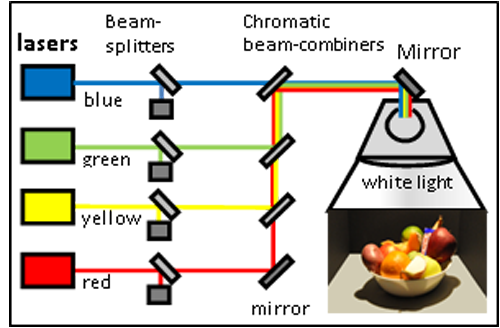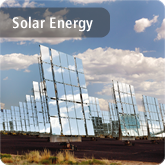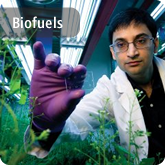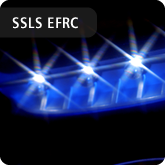
Research Challenge 6: Beyond Spontaneous Emission

- Reflectivity data from a GaN microcavity showing anti-crossing behavior and strong coupling.
This Research Challenge explores radiative processes that go beyond incoherent emission. For example, although light-emitting diodes (based on spontaneously-emitted incoherent light) are presently thought of as the source of choice for white light generation. However, coherent light sources have many potential benefits, including ultra-high efficiency, narrow linewidths, improved directionality of light, and the potential to circumvent a phenomenon called efficiency droop. If these benefits could be realized across the visible spectrum, they could provide new routes to overcoming the blue-efficiency, RYG-gap and higher-functionality-light technology challenges. Our current explorations include both “non-classical” polariton and “classical” laser sources.
However, coherent light sources for solid-state lighting are in their infancy, and much exploratory work needs to be done to understand their potential and limitations. In this Research Challenge, we are exploring two approaches to high-efficiency coherent light.

- Four color laser-based white light source for human factors study.
The first approach, comprising most of our effort, is focused on polariton sources, which entail coherent light emitted by the polaritons formed from strongly-coupled excitons and cavity photons. In the strong-coupling regime, spontaneous emission is replaced by a coherent exchange of energy between excitons and photons which can lead to polariton lasing. One major challenge is to overcome the phonon bottleneck problem which, if successfully circumvented, would allow one to utilize the fast picosecond polariton lifetime to dramatically improve optical efficiency. Though such sources have been pursued for many years, we believe they are poised for breakthroughs with the advent of high quality InGaN materials and their high exciton binding energies and oscillator strengths.
The second approach, comprising a smaller effort, is in conventional laser sources, that is, coherent light emitted by stimulated emission in the weak coupling regime. Here, we are exploring the ultimate limits of the most basic characteristics of lasers as applied to SSL. For example, what is the color quality associated with narrow linewidth sources? What are the differences between the fundamental factors that limit efficiencies of lasers (multi-pass devices) and LEDs (single-pass devices)? How might novel architectures (nanowire lasers) mitigate some of these factors?
Research Participants
- Dr. Arthur Fischer (SNL) – Principal Investigator – coordinates activities of the team; polariton laser and strong coupling experimental design and measurements.
- Prof. Steve Brueck and Alexander Neumann (Ph.D Student) (UNM) – Design and implementation of laser set-up for human factors study.
- Dr. Weng Chow (SNL) – Many-body laser theory calculations.
- Dr. Daniel Koleske (SNL) – MOVPE growth of GaN and InGaN materials.
- Dr. Willie Luk (SNL) – Optical measurements and polariton cavity designs.
- Dr. Jeff Tsao (SNL) – Human factors study, industry perspective, and economic analysis.
- Dr. Jonathan Wierer (SNL) – Nitride device design, fabrication, and testing.
Research Challenge Publications
Neumann, Alexander; Wierer, Jonathan J.; Davis, Wendy; Ohno, Yoshi; Brueck, Steve R. J. ; and Tsao, Jeffrey Y. Four-color laser white illuminant demonstrating high color-rendering quality, Optics Express, 19, A982-A990 (2011). [10.1364/OE.19.00A982]
Kabuss, Julia; Carmele, A.; Richter, M.; Chow, Weng W.; and Knorr, A. Inductive equation of motion approach for a semiconductor QD-QED: coherence induced control of photon statistics, Physica Status Solidi B, 248, 872 (2011). [DOI: 10.1002/pssb.201000851]
Carmele, A.; Richter, M.; Chow, Weng W.; and Knorr, A. Antibunching of Thermal Radiation by a Room-Temperature Phonon Bath: A Numerically Solvable Model for a Strongly Interacting Light-Matter-Reservoir System, Physical Review Letters, 104, 156801 (2010). [10.1103/PhysRevLett.104.156801]
 ECIS Highlights
ECIS Highlights













 RSS
RSS Google+
Google+ Twitter
Twitter Facebook
Facebook LinkedIn
LinkedIn YouTube
YouTube Flickr
Flickr

